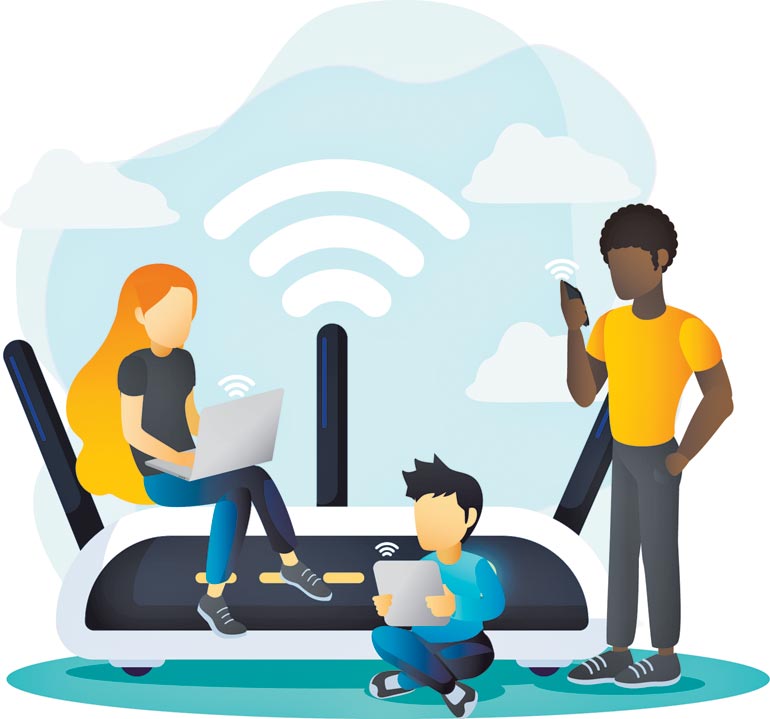Addressing gaps in PHL’s digital connectivity

With over 7,600 islands, the Philippines has always grappled with the issue of bridging the physical divide that separates its communities. Digitalization was deemed as the solution, and for the most part, it was. But not for everyone.
Paradoxically, despite its status as a nation renowned for its vibrant internet usage, the Philippines harbors one of the most substantial gulfs in digital inclusivity and adoption globally.
According to a World Bank article published on its website, 30 years after its initial connection to the internet, the Philippines’ broadband infrastructure remains woefully inadequate. Without reliable internet connectivity, digitalization — a potent driver of equitable growth, job creation, climate resilience, and sustainability — cannot be enjoyed by everyone.
The data showed that within the Association of Southeast Asian Nations (ASEAN), the Philippines stands out with only 33% of homes having access to fixed internet in 2022, while only 70% of people had a mobile broadband subscription that was active.
Both percentages are significantly lower than the 41% and 101% ASEAN averages, respectively. In ASEAN, the Philippines accounted for over half of the population without access to mobile broadband.
Looking at the “Digital 2024” report made by DataReportal in partnership with We Are Social and Meltwater, there were 86.98 million internet users in the Philippines at the start of 2024, while internet penetration stood at 73.6%. The report estimates that the population of the Philippines was at 118.2 million at the start of the year.
The data suggests that 31.24 million people in the Philippines did not use the internet at the start of 2024, and that 26.4% of the country’s population remained offline at the beginning of the year.
Additionally, the cost of broadband Internet in the Philippines is higher than in its neighboring nations. World Bank data puts Philippine fixed broadband as twice as expensive as the average for ASEAN, amounting to 11% of gross national income (GNI) per capita annually. The cost of mobile broadband was 1.5 times higher than the ASEAN average, at 2% of per capita GNI.
To make matters worse, the World Bank found that the broadband market in the Philippines is one of least invested in and concentrated in all of ASEAN — even if it is the most profitable for the stakeholders. 91% of mobile subscribers are served by two major telecommunications operators, a substantially higher percentage than the 70%-80% shared by middle-class peers in ASEAN.
The level of investment into mobile infrastructure can be gauged by the number of mobile towers per population. TowerXchange, a research organization that specializes in mobile towers, estimated that in 2022, there were 28 mobile towers per 100,000 inhabitants in the Philippines — just one-third of the average among ASEAN peers.
Between 2018 and 2022, the World Bank article noted that there was a decrease in overall investment in telecoms infrastructure, with gross capital formation in telecom infrastructure falling from 0.64% of gross domestic product (GDP) to 0.44%.
Notably, more than 100 developing nations invested at least 1% of their GDP in telecommunications in at least one year between 2006 and 2021, according to data from the International Telecommunication Union (ITU). The Philippines did not.
The World Bank further pointed out that the Philippines has perhaps the least favorable governmental environments in all of ASEAN for inexpensive broadband. Citing the country’s results on the Affordability Driver Index (ADI), the Philippines has been among the least active nations globally in advocating for inexpensive broadband reforms.
Moreover, in all five of the policy areas evaluated in the index, the Philippines’ scores decreased or only slightly improved, indicating that changes to the country’s national broadband policy, competition, spectrum policy, infrastructure sharing, and universal access either stagnated or reversed.
In contrast, 40 of the 57 developing nations that the ADI evaluated between 2017 and 2021 saw an improvement in their average scores. ASEAN neighbors that achieved notable strides were Vietnam (on spectrum), Malaysia (on competition), Indonesia (on infrastructure sharing), and Cambodia (on universal access).
Only four nations in the world — Venezuela, Nicaragua, Haiti, and Sudan — had ratings that were decreasing and worse than the Philippines.’
“Regulatory weaknesses are rooted in the Philippines’ legal system (specifically, the 1931 Radio Control Law and the 1995 Public Telecommunications Policy Act), which have not been updated, despite massive technological change,” the World Bank noted.
“Upgrading its 20th-century regulations is critical if Filipinos are to fully benefit from 21st-century technology. Urgent reforms on broadband policy would hasten the digital transformation the Philippines needs to achieve its goal of becoming a prosperous middle-class society by 2040.”
The article identifies four complementary sets of reforms that could improve access to, the caliber, and affordability of the Internet, and lower barriers to investment and competition.
These are reducing obstacles to investment and entry by doing away with the congressional franchise requirement for the installation of broadband networks; giving different market actors the same opportunity to invest in broadband infrastructure; providing for the effective and adaptable use of the radio frequency spectrum while democratizing spectrum access; and encouraging the sharing of passive infrastructure and requiring government organizations and regulators to coordinate the deployment of infrastructure.
“Equitable access to broadband services is imperative to narrow the digital divide and for more people to benefit from digitalization. Limited internet access curbs digital potential for citizens and businesses, with peri-urban connectivity being critical to future growth,” the World Bank said in a policy note titled “Better Internet for All Filipinos: Reforms Promoting Competition and Increasing Investment for Broadband Infrastructure.”
“Policy makers can build on immediate reforms through the open access bill as an entry point to broader and medium- to longer-term digital connectivity agenda. The cost of inaction — loss of growth opportunity, people remaining unequipped for future jobs, and widening of the digital divide — is too high for the Philippines.” — Bjorn Biel M. Beltran



